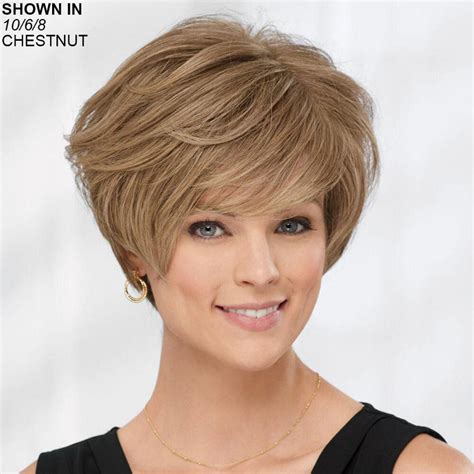As women age, their hair may undergo significant changes, including thinning, loss of volume, and texture alterations. For many older women over 50, wigs offer a versatile and effective solution to enhance their appearance, boost their confidence, and regain a sense of empowerment.

Benefits of Wigs for Older Women
- Restore volume and density: Wigs can instantly add volume to thinning hair, creating the illusion of a fuller, more youthful appearance.
- Conceal hair loss: Wigs provide a discreet and comfortable way to cover hair loss caused by medical conditions, alopecia, or aging.
- Experiment with different styles: Wigs allow older women to explore various hairstyles and colors without committing to a permanent change.
- Protect sensitive scalps: Wigs can act as a barrier between sensitive scalps and harsh environmental factors, providing sun protection and reducing irritation.
- Boost confidence and self-esteem: Wearing a wig can significantly enhance self-confidence by restoring a sense of control over one’s appearance.
Choosing the Right Wig for Older Women
Selecting the perfect wig for older women requires careful consideration of various factors, including:
- Face shape: Determine the shape of your face (oval, round, square, etc.) to choose a wig that complements your facial features.
- Skin tone: Wigs with colors that match or enhance your skin tone will create a more natural and flattering look.
- Hair type: Choose a wig with a texture and thickness similar to your natural hair to achieve a realistic appearance.
- Comfort: Opt for wigs made of breathable materials and adjustable straps to ensure maximum comfort during wear.
- Budget: Wigs come in a wide range of prices, so set a budget before shopping to avoid overspending.
Common Types of Wigs for Older Women
The wig market offers a vast selection of options tailored specifically for older women. Some of the most popular types include:
- Synthetic wigs: Made from artificial fibers, these wigs are affordable and come in a wide variety of colors and styles. They require less maintenance than human hair wigs.
- Human hair wigs: These wigs are more expensive but provide the most natural look and feel. They can be styled with heat tools and last longer than synthetic wigs.
- Lace front wigs: These wigs feature a sheer lace frontal that creates the illusion of a natural hairline. They offer a higher level of customization and can be parted and styled as desired.
- Mono top wigs: These wigs have a monofilament top that provides the appearance of individual hairs growing from the scalp. They offer a more realistic look and allow for more parting options.
Effective Strategies for Wig Wearers Over 50
To make the most of your wig and enjoy its benefits, follow these effective strategies:
- Consult with a hairstylist: An experienced hairstylist can guide you in choosing the right wig, provide styling tips, and ensure a comfortable fit.
- Maintain your wig regularly: Wigs require regular washing, conditioning, and styling to maintain their appearance and longevity.
- Be mindful of scalp care: Wash your scalp regularly to prevent irritation and build-up, even if you’re wearing a wig.
- Protect your wig from damage: Avoid extreme heat, harsh chemicals, and excessive brushing to extend the lifespan of your wig.
- Embrace your wig: Wear your wig with confidence and embrace the freedom and joy it brings to your life.
Common Mistakes to Avoid When Wearing a Wig
To avoid common pitfalls and maximize the benefits of your wig, be aware of these mistakes:
- Choosing the wrong size: A wig that is too small will feel uncomfortable and can cause headaches, while a wig that is too large may slip around or look unnatural.
- Neglecting maintenance: Failure to wash and style your wig regularly can lead to tangles, mats, and premature wear.
- Over-styling your wig: Using too much heat styling tools or brushing your wig excessively can damage the fibers and shorten its lifespan.
- Wearing your wig too tightly: A wig that is too tight can restrict blood flow to your scalp and cause discomfort.
- Being afraid to experiment: Don’t be afraid to try different hairstyles and colors with your wig. Experimentation is key to finding the look that best suits you.
1. How often should I wash my wig?
The frequency of washing your wig depends on how often you wear it and the type of wig you have. Generally, synthetic wigs should be washed every 6-8 wears, while human hair wigs can be washed every 10-12 wears.
2. Can I use regular shampoo and conditioner on my wig?
No, do not use regular shampoo and conditioner on your wig. Use products specifically designed for wigs to avoid damaging the fibers.
3. How do I store my wig when I’m not wearing it?
When not in use, store your wig on a wig stand or mannequin to maintain its shape. Avoid storing it in direct sunlight or humid environments.
4. Can I swim in my wig?
It is not recommended to swim in your wig, as chlorine and other chemicals in pool water can damage the fibers.
5. Can I dye my synthetic wig?
Synthetic wigs should not be dyed, as the chemicals in hair dye can damage the fibers.
6. How long will my wig last?
The lifespan of a wig varies depending on the type of wig, how often it is worn, and how well it is maintained. With proper care, synthetic wigs can last 6-8 months, while human hair wigs can last up to a year or longer.
Wigs offer a unique and versatile solution for older women over 50 to enhance their appearance, boost their confidence, and embrace a sense of empowerment. By choosing the right wig, following effective strategies, and avoiding common mistakes, older women can enjoy the benefits of wigs for many years to come.
